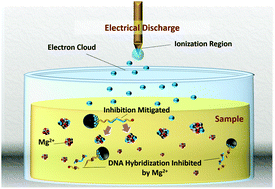A simple reagent-less approach using electrical discharge as a substitution for chelating agent in addressing genomic assay inhibition by divalent cations†
Abstract
Electrical discharge treatment was shown to be a viable substitution for chelating agent in genomic assays. Divalent cation Mg2+ inhibits the performance of DNA hybridization based genomic assays by binding to the DNA and disrupting DNA hybridization. Until now, chelating agents such as ethylenediaminetetraacetic acid (EDTA) was the only option to address the presence of Mg2+ in samples. However, EDTA is a well-known environmental contaminant. In this work, we successfully employed electrical discharge instead of EDTA to render Mg2+ insipid. Its preliminary efficacy was first observed via circular dichroism (CD) and zeta potential analyses. After electrical discharge treatment, the reduction in CD shift at 280 nm was significant for samples with 10−3 and 10−8 M Mg2+. The zeta potential of Mg2+ laden samples were also restored from −4.71 ± 1.38 to −20.59 ± 6.37 mV after electrical discharge treatment. Both CD shift and change in zeta potential suggested that 2 min of electrical discharge treatment could prevent Mg2+ from binding to DNA. The complete efficacy of electrical discharge treatment was demonstrated with the performance recovery (within ∼15% of the control) of a genomic assay variant (NanoGene assay) while analyzing Mg2+ laden samples (10−5–10−3 M). Assuming 10 million samples are analyzed annually, the proposed electrical discharge treatment (∼50 mW per sample) would allow us to trade environmental contamination by ∼50 kg of hazardous EDTA with a single 250 W STC (standard test conditions) solar panel.



 Please wait while we load your content...
Please wait while we load your content...